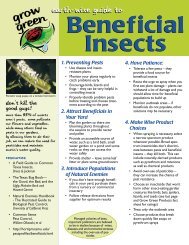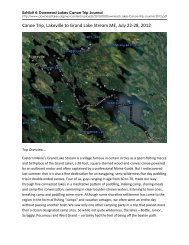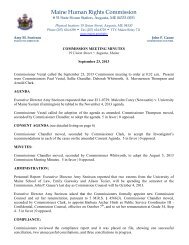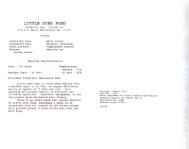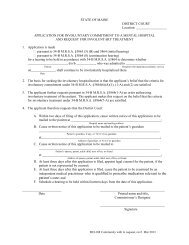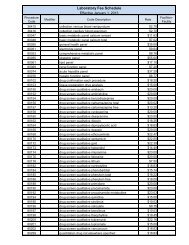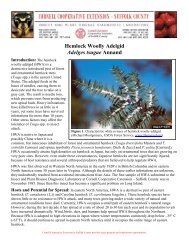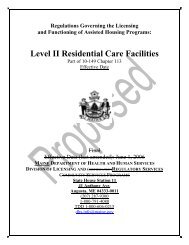TICK-BORNE DISEASES IN MAINE - Maine.gov
TICK-BORNE DISEASES IN MAINE - Maine.gov
TICK-BORNE DISEASES IN MAINE - Maine.gov
Create successful ePaper yourself
Turn your PDF publications into a flip-book with our unique Google optimized e-Paper software.
Lyme disease<br />
treatment<br />
The regimens listed below are guidelines only and may need to be adjusted depending<br />
on a patient’s age, medical history, underlying health conditions, pregnancy<br />
status or allergies. Consult an infectious disease specialist for the most current<br />
treatment guidelines or for individual patient treatment decisions. †<br />
Early Localized Stage<br />
age category drug dosage maximum duration<br />
(days/<br />
range)<br />
Adults Doxycycline 100 mg<br />
twice per day<br />
orally or IV<br />
Cefuroxime axetil<br />
Amoxicillin<br />
500 mg<br />
twice per day<br />
500 mg<br />
3 times per day<br />
Children Amoxicillin 50 mg/kg<br />
per day in<br />
3 divided doses<br />
Doxycycline<br />
Cefuroxime axetil<br />
4 mg/kg<br />
per day in<br />
2 divided doses<br />
30 mg/kg<br />
per day in<br />
2 divided doses<br />
N/A 14 (14-21)<br />
N/A 14 (14-21)<br />
N/A 14 (14-21)<br />
500 mg<br />
per dose<br />
100 mg<br />
per dose<br />
500 mg<br />
per dose<br />
14 (14-21)<br />
14 (14-21)<br />
14 (14-21)<br />
note: For patients intolerant of<br />
amoxicillin, doxycycline, and cefuroxime<br />
axetil, the macrolides azithromycin,<br />
clarithromycin, or erythromycin may<br />
be used, although they have a lower<br />
efficacy. Patients treated with macrolides<br />
should be closely observed to ensure<br />
resolution of clinical manifestations.<br />
Treatment guidelines for patients with<br />
disseminated or late stage Lyme disease<br />
are outlined in the references.†<br />
REFERENCES<br />
American Academy of Pediatrics. Lyme disease<br />
(Lyme borreliosis, Borrelia burgdorferi infection).<br />
In: Pickering LK, Baker CJ, Long SS, McMillan JA,<br />
eds. Red Book: 2009 Report of the Committee on<br />
Infectious Diseases. 28th ed. Elk Grove Village, IL:<br />
American Academy of Pediatrics; 2009: 430-435.<br />
Bunikis J., Barbour A. Laboratory Testing for<br />
Suspected Lyme Disease. Medical Clinics of North<br />
America. 2002; 86(2): 311-340.<br />
Centers for Disease Control and Prevention. Case<br />
Definitions for Infectious Conditions Under Public<br />
Health Surveillance. http://www.cdc.<strong>gov</strong>/ncphi/<br />
disss/nndss/casedef/case_definitions.htm. Accessed<br />
12/10/2009.<br />
Nadelman RB. The Clinical Spectrum of Early<br />
Lyme Borreliosis in Patients with Culture-Confirmed<br />
Erythema Migrans. The American Journal of<br />
Medicine. 1996; 100: 502-508.<br />
Steere AC, et al. The Early Clinical Manifestations<br />
of Lyme disease. Annals of Internal Medicine.<br />
1983; 99: 76-82.<br />
Steere AC. Borrelia burgdoferi (Lyme Disease,<br />
Lyme Borreliosis). In: Mandell GL, Bennett JE,<br />
Dolin R, editors. Mandell, Douglas, and Bennett’s<br />
Principles and Practice of Infectious Diseases. 7th<br />
ed. Philadelphia, PA: Churchill Livingstone; 2010.<br />
p. 3071-3081.<br />
†Wormser GP, Dattwyler RJ, Shapiro ED, et al. The<br />
Clinical Assessment, Treatment and Prevention of<br />
Lyme Disease, Human Granulocytic Anaplasmosis,<br />
and Babesiosis. Clinical Practice Guidelines by the<br />
Infectious Diseases Society of America. Clinical<br />
Infectious Diseases. 2006; 43: 1089-1134.



